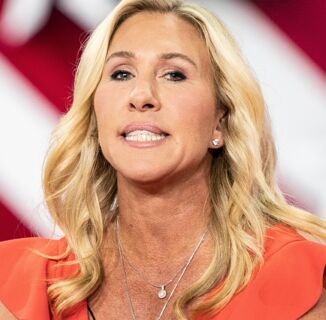The exit polls are starting to roll in after Tuesday’s midterm elections, and the results show a higher turnout of LGBTQ voters than has ever been counted in previous U.S. elections.
According to the National Election Pool exit poll results, queer and trans people made up six percent of all voters this year. It may not seem like much, but that’s up from the previous record of four percent.
LGBTQ Americans overwhelmingly voted for the Democratic ticket on Tuesday, with 82 percent identifying themselves as Democrats.

That’s not surprising, said Gary Gates, a leading expert in LGBTQ demographics and former director of the Williams Institute at UCLA.
“Several factors could explain historically high support for Democrats among LGBT voters, with the caveat that such support has always been quite high,” Gates said in an email to INTO. “LGBT people may feel particularly threatened by the Trump administration given, for example, their open hostility toward the transgender community and efforts to minimize the inclusion of sexual orientation and gender identity measurement on major federal surveys.”
It’s unclear whether the higher percentage of LGBTQ voters is due to higher engagement — likely a response to the Trump administration, as Gates mentioned — or due to the fact that a record number of young people identify as LGBTQ.
According to the National Election Pool (NEP) results, voters aged 18-44 made up 35 percent of the voting population. And voters tended to lean more to the left as they got younger; while 58 percent of those ages 30-44 reported voting Democrat, a larger 67 percent of young voters age 18-29 cast their ballots for the blue wave.

Gates also added that young women are more likely to identify on the LGBTQ spectrum, and “Young women are much more likely to support Democrats.”
Exit polls are not the final word on voting trends, though, especially since there are so few of them. A new poll launched this year, conducted by the Associated Press and the University of Chicago’s NORC center for public affairs research, offers a different set of numbers — some of which are surprising.
The AP-NORC exit poll also found that LGBTQ voters made up six percent of the overall voting pool, but found only 73 percent of those voted Democrat, in contrast to the NEP’s larger number.
Most surprising, though, were the results of AP-NORC’s breakout dataset on transgender voters. Trans voters, according to the poll, made up one percent of voters overall; while the majority voted Democrat at 60 percent, a fairly heavy 36 percent of trans people said they voted Republican.

INTO did not immediately receive a response from NORC after requesting more information about LGBTQ voter data.
But Elliot Imse of the LGBTQ Victory Fund, the nation’s largest political action group funding and endorsing LGBTQ candidates, called exit polls “notoriously imprecise” and questioned some of the AP-NORC results.
“It seems extremely unlikely that 36 percent of transgender people voted Republican given the party’s vilification of the trans community at the federal level and in so many state legislatures,” said Imse. “There are pro-trans equality Republican elected officials out there, certainly, but unfortunately right now they are hard to come by.”
The surprisingly high number of trans Republican voters polled by AP-NORC could be due to a number of factors in how poll data is collected. Trans people make up a very small percentage of the overall population at an estimated 0.6 percent, and the AP-NORC poll sampled a pool of 95,000 people online in addition to another 28,000 people contacted by phone and mail.
AP-NORC said trans voters made up one percent of survey respondents, a rate higher than the trans percentage of the overall population. That means out of a total survey of 123,000, just over 1,000 trans voters responded. But because the pollsters relied on voters to self-identify, there’s no way to prove that all people responded accurately; hypothetically, a few Republicans could have easily decided to troll the survey by saying they were transgender.
Such poll results might not normally be questioned, but the trans numbers collected by AP-NORC fly in the face of previous data. According to the 2015 U.S. Trans Survey, the most comprehensive data set available on transgender Americans, only 2 percent of trans people identified themselves as Republicans.
But only half of the 28,000 trans people in the 2015 U.S. Trans Survey said they were Democrats. With 48 percent identifying themselves as Independents, it’s possible that some tactically shifted to Republican in order to vote for (or against) specific candidates in this year’s midterms. In addition, three LGBTQ Republicans won seats this week in races that likely drew higher engagement among LGBTQ voters.
Without more specific polling data on LGBTQ voters, it’s hard to determine overall trends in terms of why, when, and for whom LGBTQ people decide to vote. But one thing we do know for sure is that a record-breaking number of openly LGBTQ candidates were elected to office as a result of this week’s midterm elections. Over 157 queer and trans political leaders will join the government after this week, and as the number of LGBTQ voters increases with each election — representation in government is likely to continue to increase as well.
Don't forget to share:
Help make sure LGBTQ+ stories are being told...
We can't rely on mainstream media to tell our stories. That's why we don't lock our articles behind a paywall. Will you support our mission with a contribution today?
Cancel anytime · Proudly LGBTQ+ owned and operated
Read More in Impact
The Latest on INTO
Subscribe to get a twice-weekly dose of queer news, updates, and insights from the INTO team.
in Your Inbox












